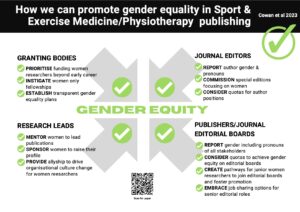Keywords: gender, publishing, equity
As a collective of women researchers we are conscious of gender inequality. Gender inequality had been well documented in many scientific fields including Sports Science, but not in our fields of Sport and Exercise Medicine/ Physiotherapy. We were interested to investigate whether there was a more equal representation of genders in authorship in our fields of research, given that women are graduating in similar numbers to men. This blog is based on our recent study published in the BJSM which explored how we can take action to prevent gender and sex inequity (1).
The biggest challenge to this research was navigating the complexities of understanding the representation of sex and gender in the peer review publications we examined. In our paper (1) we detail that despite sex and gender being distinct and non-binary constructs (2) sex and/or gender are rarely defined, and often erroneously used interchangeably (e.g., women/man used to describe sex, or female/male used to describe gender). The methods to assess gender and/or sex are usually poorly described and reported as binary. This results in a proportion of the population not being represented accurately, making it difficult to interpret and apply study findings and challenging to synthesise gender and or sex data. Due to these challenges we used the term gender/sex and the more inclusive phrases of women and men in our paper, acknowledging and apologising that some people will have been misclassified.
Why is this study important?
This is the first study to investigate sex/gender representation of research author leadership and research participants in sport and exercise medicine/physiotherapy peer review publications.
How did the study go about this?
This labour intensive study required manual extraction of all articles in each of the journals included. Each article was downloaded and key information extracted including study type, gender of authors, number and sex/gender of participants and statistical analysis of groups based on sex/gender. Identifying the gender of each author often required extensive trawling of university biographies, LinkedIn, Research Gate and social media. We extracted data for a two year time period for each journal and again 10 years later to investigate whether there were differences over the 10 year period between 2008/2009 and 2018/2019.
What did the study find?
Consistent with other scientific fields, women were poorly represented as first and last authors of research and women participants poorly represented in research. Disappointingly little had changed in the 10 period between our assessments. In 2018/2019 women authors accounted for only 33% of first and last author positions on original research articles, and 25% of editorial/opinion pieces first authors. Women participants were also under-represented; in the four years studied, only 10% of > 7.5 million participants involved in original research were women. Importantly having more women in leadership positions (First and last author) resulted in an increase (8.5%) in women participants in original research studies.
What are the key take-home points?
It is clear that sport and exercise medicine/physiotherapy has gender/ sex equity problems; the essential question is what can the field do to fix this problem?
We feel these striking results demand bold actions to close both the author and participant gender gap in sport and exercise medicine/physiotherapy publishing. This is vital to stop women’s careers being systematically impeded by gender/sex assumptions and stereotype (3) and to address the inequity in research participation. We propose four pragmatic actions (targeting Granting Bodies, Publishers, Editors & Editorial boards and Research Leads) to close the gender/sex gap in author representation and leadership, and five (targeting editors, authors and researchers) to address women participant representation in sport and exercise medicine/physiotherapy research.

Author of blog:
Dr Sallie Cowan
MACP | APA Musculoskeletal Physiotherapist | Senior Research Fellow
La Trobe Sport and Exercise Medicine Research Centre
References:
- Cowan SM, Kemp JL, Ardern CL, et al. Sport and exercise medicine/physiotherapy publishing has a gender/sex equity problem: we need action now! Br J Sports Med 2023 doi: 10.1136/bjsports-2022-106055 [published Online First: 20230111]
- Miller VM. Why are sex and gender important to basic physiology and translational and individualized medicine? American journal of physiology Heart and circulatory physiology 2014;306(6):H781-8. doi: 10.1152/ajpheart.00994.2013 [published Online First: 20140110]
- Singer M. Beyond bias and barriers. Science 2006;314(5801):893. doi: 10.1126/science.1135744